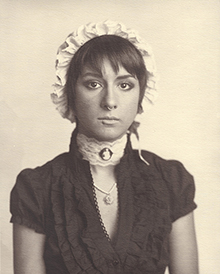By Menachem Wecker
When Rembrandt sought models for his biblical subjects, he used his Jewish neighbors in 17th-century Amsterdam as models and dressed them from his large collection of classical costumes. In his 2005 painting of Ice T, Kehinde Wiley depicted the rapper and actor sitting on a throne and donning a majestic red robe worthy of Louis XIV. The pose exactly matches Jean-Auguste-Dominique Ingres’ 1806 portrait of Napoleon.
GW Today photo editor William Atkins’ 2008 black-and-crème photograph A Belle of Modernity shows a young woman wearing a bonnet, black dress and a neck cloth – all full of frills. It takes a moment for the viewer to realize the model, who is Mr. Atkins’ friend and former classmate, has a nose ring.
Like Mr. Wiley and Mr. Ingres before him, Mr. Atkins’ work, which is part of his series of 21 photos, The Iguanodon Portraits, captures contemporary models in obsolete attire. Unlike some of his artistic predecessors, though, Mr. Atkins joins form and content.
“A lot of the materials I use are no longer manufactured,” says Mr. Atkins, whose series of portraits is on exhibit at Mackall House in Fairfax, Va., through Dec. 20. “I’ve developed a reputation for working with these materials, so family and friends are on the lookout for different films and papers for me.”
The series features 19th-century photographic printing techniques like the cyanotype, an iron-based blue print. Mr. Atkins’ camera yields an 8” x 10” negative, which he develops in a series of trays of chemicals and water in his bathtub. After drying the negative, he places it directly on top of the printing surface – usually very thick watercolor paper – which transfers the image from the negative to the paper. The printing process takes about an hour.
“I use an antique camera that is more or less a refined version of the cameras used during the Victorian era,” Mr. Atkins says.
The exhibit juxtaposes the 19th-century technique with more contemporary silver gelatin prints, which are created in a traditional black-and-white darkroom.
The show, which is curated by Page Carr and includes photographs by Matthew Dols and Devon Johnson, is hung in an interesting setting. Built in the mid-19th century, Mackall is a three-story house with large windows and rooms and high ceilings. Though Mr. Dols’ photographs use modern styles, Mr. Atkins’ and Mr. Johnson’s photographic techniques are contemporary to the house.
The Iguanodon series title derives from a Latin name for a duck-billed dinosaur. As Mr. Atkins notes in an artist’s statement, the first recognized dinosaur fossils were discovered in the Victorian era. But those fossils were incomplete, and scholars soon realized the fossils had been incorrectly interpreted.
“If photography can be considered a fossilization of time,” as the contemporary Japanese photographer Hiroshi Sugimoto has claimed, “then these portraits can be looked upon like the early dinosaur models as correct until a closer look is taken,” says Mr. Atkins.
“It is my goal that upon first glance, the photograph will be taken at face value,” continues the statement. “Upon closer inspection, the viewer will find all is not as it seems; anachronisms and inaccuracies flourish in varying degrees.”
The subject of "Professor Y" exhibits one such anachronism. The mustachioed man wears a light dress shirt and pants, a bowtie and a safari hat and sits in a wicker chair. A globe, symbolic of his travels, peeks out from behind his right elbow, and he holds a book in his hand. The out-of-time accessory is the bling around the professor-explorer’s neck: the sort of chain with a large dollar sign that one would expect to see Sacha Baron Cohen wear while playing Ali G.
According to Mr. Atkins, his subjects’ antiquated costumes should encourage viewers to consider what makes things modern and what makes them timeless, what could have been and what might be on the horizon.
“Most importantly, the viewer should consider who this character that is being portrayed is,” he says, “and ask what kind of world he or she comes from.”
Mackall House is located at 3430 Preservation Drive in Fairfax. The exhibit will be open on December 19-20 from noon to 6 p.m.


